Overview
This blog is to showcase examples and updates of the Geostationary Lightning Mappers (GLMs) on the GOES-East and -West satellites. It is maintained by scientists at the NOAA's Cooperative Institute for Satellite Earth System Studies (CISESS), located in the Discovery District at the University of Maryland, College Park. If you have any questions, comments, or suggestions about the CIMSS Satellite Blog, feel free to send us email. You can also follow us on Twitter @goesglm or on Youtube www.youtube.com/channel/UC4RfgtjUbotawHh7UzCRBAw.
11/27/22
Lightning in winter storms is not very common in the greater D.C. area. On November 27, 2022, the Mid-Atlantic Lightning Mapping Array (MALMA), a 16-sensor network operated and maintained by the UMD lightning team, was able to detect some winter lightning. At least, 8 flashes were detected during the hour of 1900-2000 UTC (see Fig. 1). The NOAA Geostationary Lightning Mapper on the GOES-16 Satellite also detected the winter lightning (see Fig. 2). Winter lightning and storms are known to have different features from summer ones. The UMD lightning team is in the process of analyzing this rare event.


11/27/22
Daile Zhang has published a conference paper, which was presented by the co-author Ron Holle, a former meteorologist for Vaisala as well as NOAA at the 36th International Conference on Lightning Protection in Cape Town, South Africa during October 2-7, 2022. The paper is titled “The epidemiology of lightning in Mainland China - A review of two datasets from the 1950s to 2018” by Zhang and Holle (DOI: 10.1109/ICLP56858.2022.9942574).

11/6/22
CISESS lightning team Guangyang Fang, Alex Friedman, Domenic Brooks, Samantha Smith, and Daile Zhang, as well as an AOSC grad student Alvin Cheung attended the 2022 Mid-Atlantic ChaserCon, held at the Science Museum of Virginia in Richmond, VA on Nov. 5th, 2022. This year, the ChaserCon organized a new student section the day before the ChaserCon meeting (Nov. 4th). AOSC undergraduate and graduate students Alex Friedman, Domenic Brooks, Samantha Smith, and Alvin Cheung presented at the student section. The conference aims to provide a forum for meteorologists at National Weather Service, broadcast meteorologists, emergency managers, storm chasers and other professional and amateur meteorologists across the great Mid-Atlantic area to network and discuss local severe storms and promote ideas to raise public awareness of severe weather and emergency management.






11/4/22
On Thursday, October 27th, 2022, CISESS Scientist Joseph Patton presented virtually in a workshop which prepared forecasters from across the African continent for seeing and using geostationary lightning observations in their operations. The Meteosat Third Generation Lightning Imager (MTG-LI) instrument is expected to be launched into orbit later this year, providing forecasters across Europe and Africa with geostationary lightning mapper observations for the first time. In this workshop, imagery was shown from several case studies observed with the Geostationary Lightning Mapper (GLM) instruments, which cover much of the Western Hemisphere. The relationship between GLM/MTG-LI lightning observations and severe weather events such as tornadoes, flash flooding, large hailstones, and damaging winds was interactively explored with the forecasters so that they could be better prepared to interpret ongoing lightning observations and discern severe weather potential. This workshop was supported by EUMETSAT, the intergovernmental European satellite agency responsible for the launch and operation of the upcoming MTG-LI instrument, and by COMET, an educational institution sponsored by the US National Weather Service, which creates and distributes training materials to Earth system scientists.

9/14/22
A hybrid GLM Science Meeting was held in Huntsville, AL on September 13-15. Roughly 70 online participants joined 40 in person attendees to make this our most successful meeting yet. Over 3 days, 54 presenters described their recent work on GLM calibration and validation, operational use, and science and applications.

9/12/22
A rare cloud-to-ground flash with long continuing current was recorded by a Raspberry Pi camera in Flagstaff, AZ on Aug. 1, 2022. The flash had three strokes to ground reported by two ground-based networks - Earth Networks Total Lightning Network (ENTLN) and National Lightning Detection Network (NLDN), but the striking points were out of the field of view of the camera. The entire flash lasted for 45 frames, which was approximately 500 milliseconds with long continuing current. The long continuing current lasted for 37 frames, which was about more than 400 milliseconds. Only 4% of the negative cloud-to-ground flash were reported having a continuing current longer than 400 milliseconds. Unfortunately, neither GLM-16 or -17 detected this flash due to the low peak current in the channel.
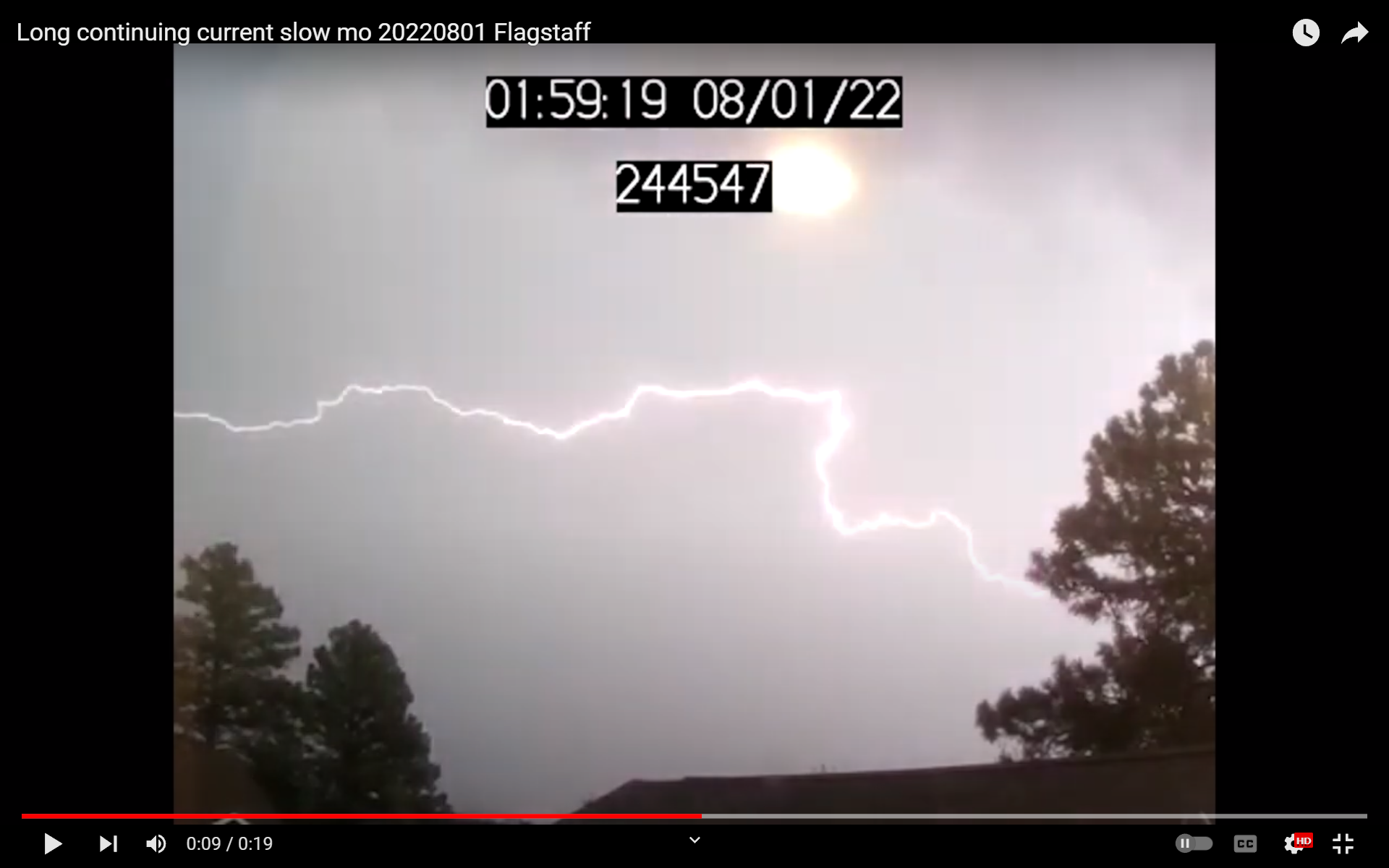
9/12/22
On Aug. 4, 2022, there was a severe storm with very active lightning flashes sweeping over the greater D.C. area, causing three lightning fatalities and one in critical conditions after lightning struck near the D.C. White House. According to Washington Post: “Four people — two men and two women — were critically hurt in the strike just before 7 p.m. in the center of the park, in a grove of trees about 100 feet southeast of the statue of Andrew Jackson …” “Three people, including a Wisconsin couple celebrating their 56th wedding anniversary, have died after a lightning strike Thursday evening in Lafayette Square, just north of the White House, D.C. police said Friday.” About 100 total lightning discharges were reported by the National Lightning Detection Network (NLDN) within ~3 km of the statue within the 10 minutes before the deadly strike, which was a reflection on personal safety and warning concern.
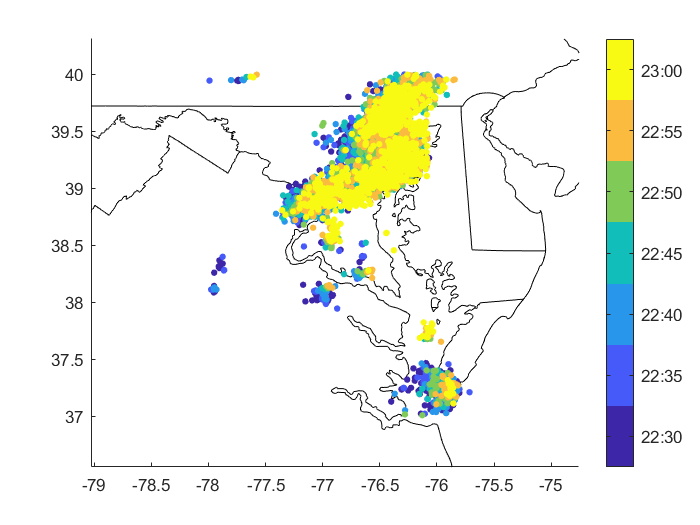
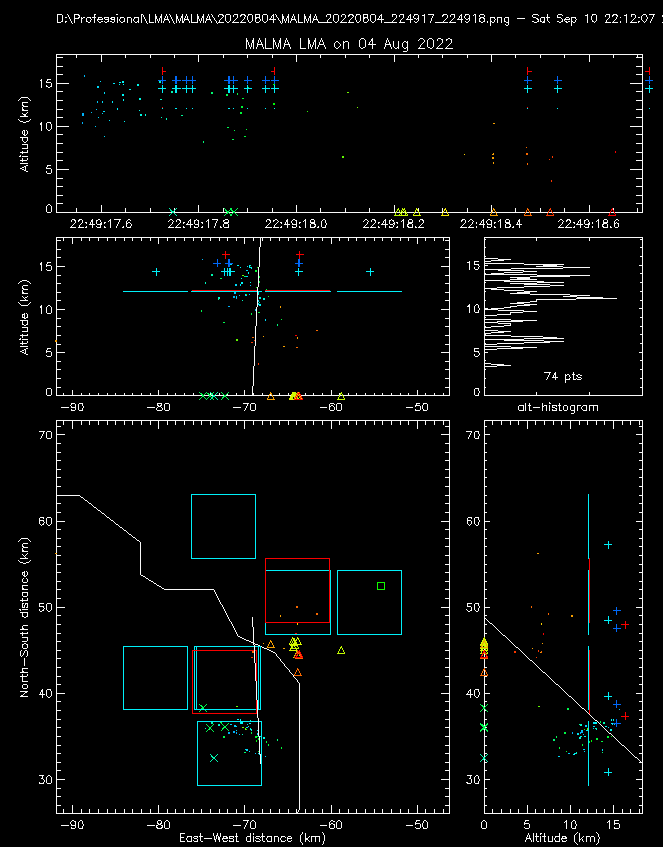

8/31/22
Daile Zhang was invited to serve on the Board of Directors and Executive Committee of the African Centres for Lightning and Electromagnetics Network (ACLENet). ACLENet is a not-for-profit organization with national centres in Africa registered as a non-governmental organizations (NGO) or companies limited by guarantee, dedicated to decreasing deaths, injuries and property damage from lightning in the pan-Africa area.
8/25/22
At 10:00 AM, August 25th, 2022, Dr. Guangyang Fang visited the Wallops LMA station at the Unmanned Aircraft Systems Test Site of the University of Maryland (UMD_UAS) in California, MD to fix the GPS issue. This site is southeast of ESSIC, about 70 miles away. This site was reported to have a bad GPS connection. Since the computer still communicated with the GPS board, the issue was most likely a bad cable. After the inspection upon arriving at the site, Guangyang found that the GPS cable was cut off from the end near the ground as seen in Figure 1. The connector to the LMA sensor was cut off and a short piece of cable after it was also cut off. It seemed that it was bitten by some animal such as a mouse. The GPS was replaced with a good spare and the station was functioning well again. Guangyang wrapped up the interface between the connector and the cable with electrical tape to make sure the same issue won’t happen again.
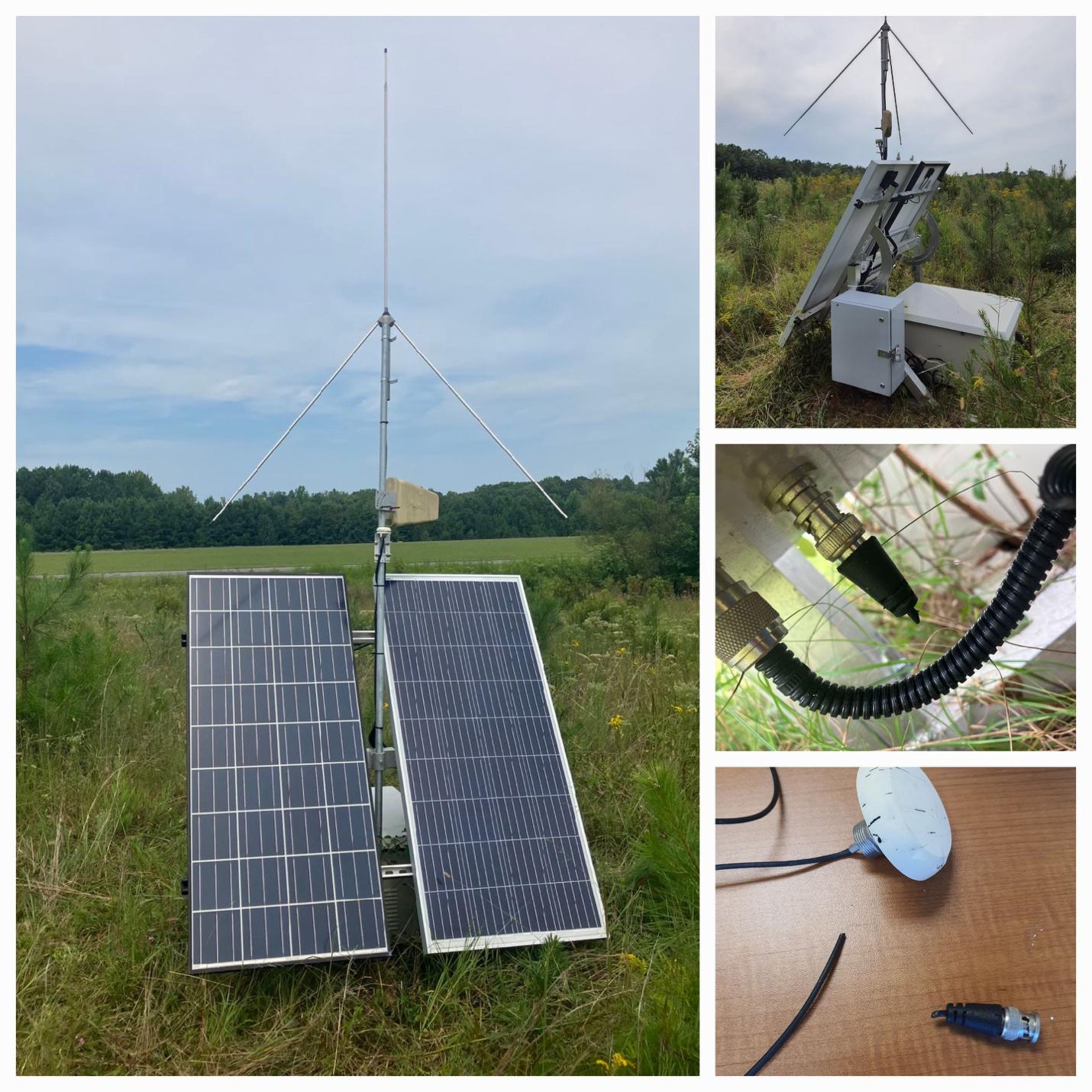
6/29/22
A Raspberry Pi camera was installed last week at an Earth Networks contractor's house in Flagstaff, Arizona. Since then, the camera has been used to take relatively high-speed videos of lightning and captured lightning flashes on June 26. The camera is located in the area where both GOES-16 and -17 (will be replaced by -18) have observations. The videos will be used for ground-truth evaluations for the Geostationary Lightning Mapper (GLM) instruments on these satellites. Currently, there are a total of 6 cameras in operation in Maryland and Arizona.
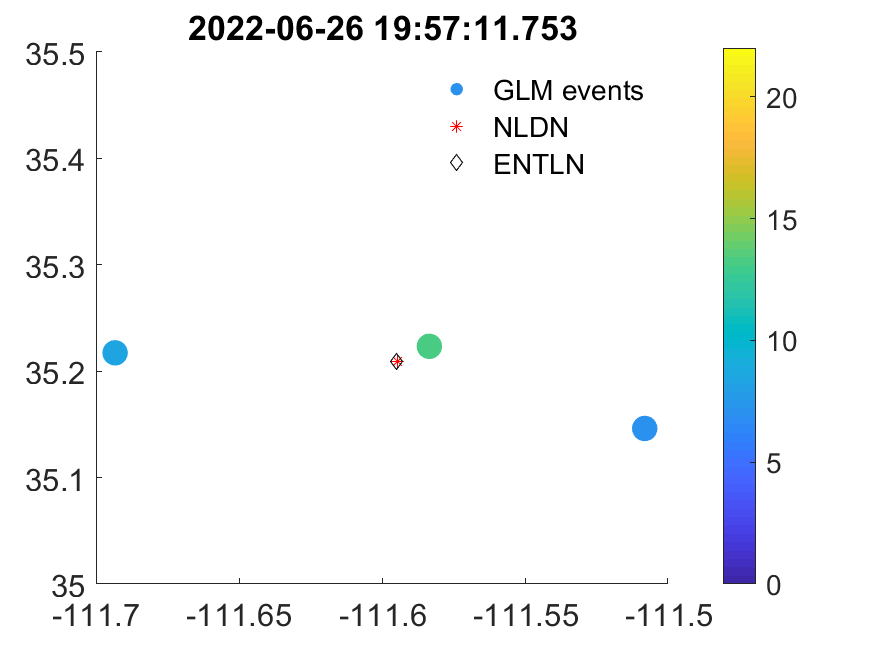

6/26/22
On June 26, 2022, a storm passed over the Flagstaff area. The camera captured an 11-stroke CG flash. Unfortunately, only one visible channel was in the field of view (Left). All other strokes were a few miles on the south side of the camera with only illuminations on the frames without visible channels. The video frames were compared with the GLM and two ground-based measurements: the National Lightning Detection Network (NLDN) and the Earth Networks Total Lightning Network (ENTLN). In addition, both GLM-16 and 17 observations of the same flash were compared. The study will give us a better understanding of the differences in the two instruments, and how we can correct the satellite geolocations. The full video is available at: https://youtu.be/_hZj1E_MRsw. The flash starts at 3:36:08.
Left: A cloud-to-ground stroke was captured by the camera. Right: The plan view of the stroke detected by GLM and ground-based measurements. The dots are the GLM-16 pixels, color-coded by energy. The red symbol and the black diamond symbol are the stroke reported by the NLDN and ENTLN. The blue star shows where the camera is located.
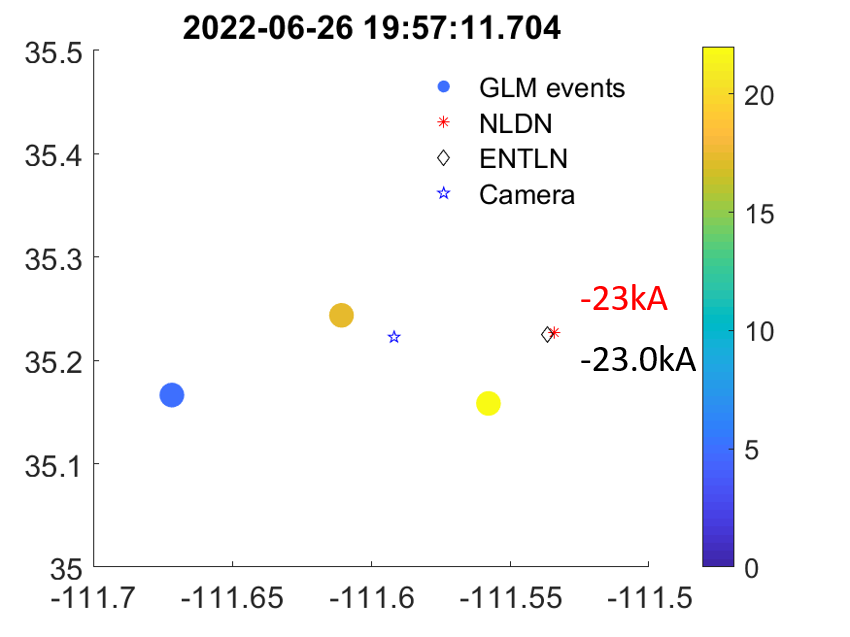
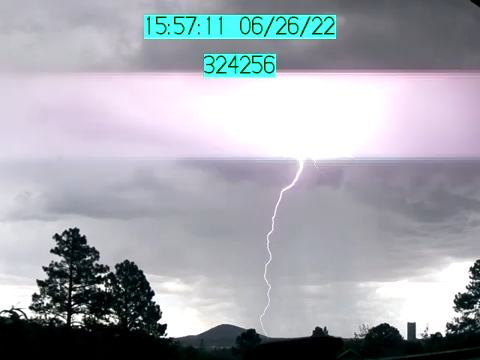
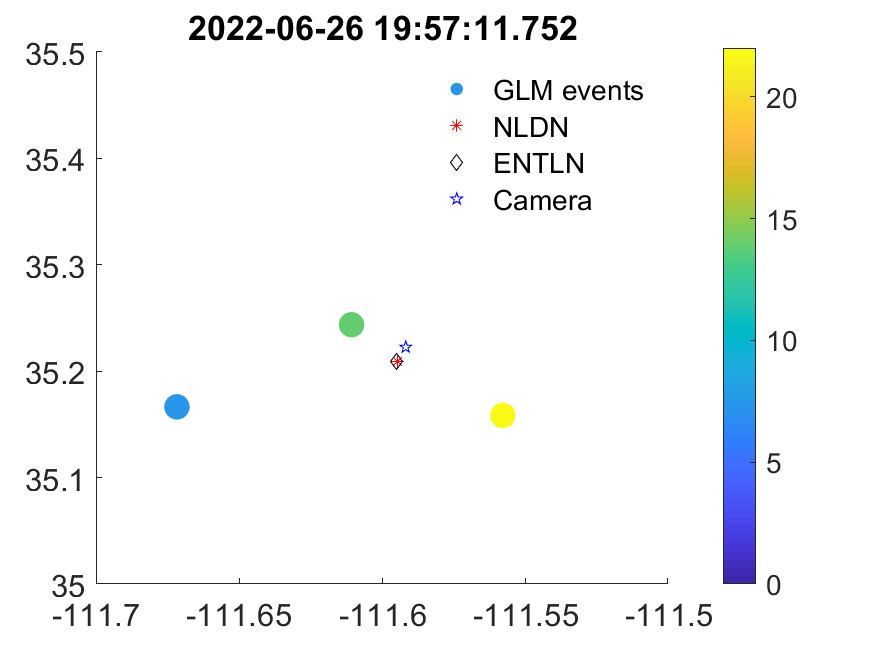
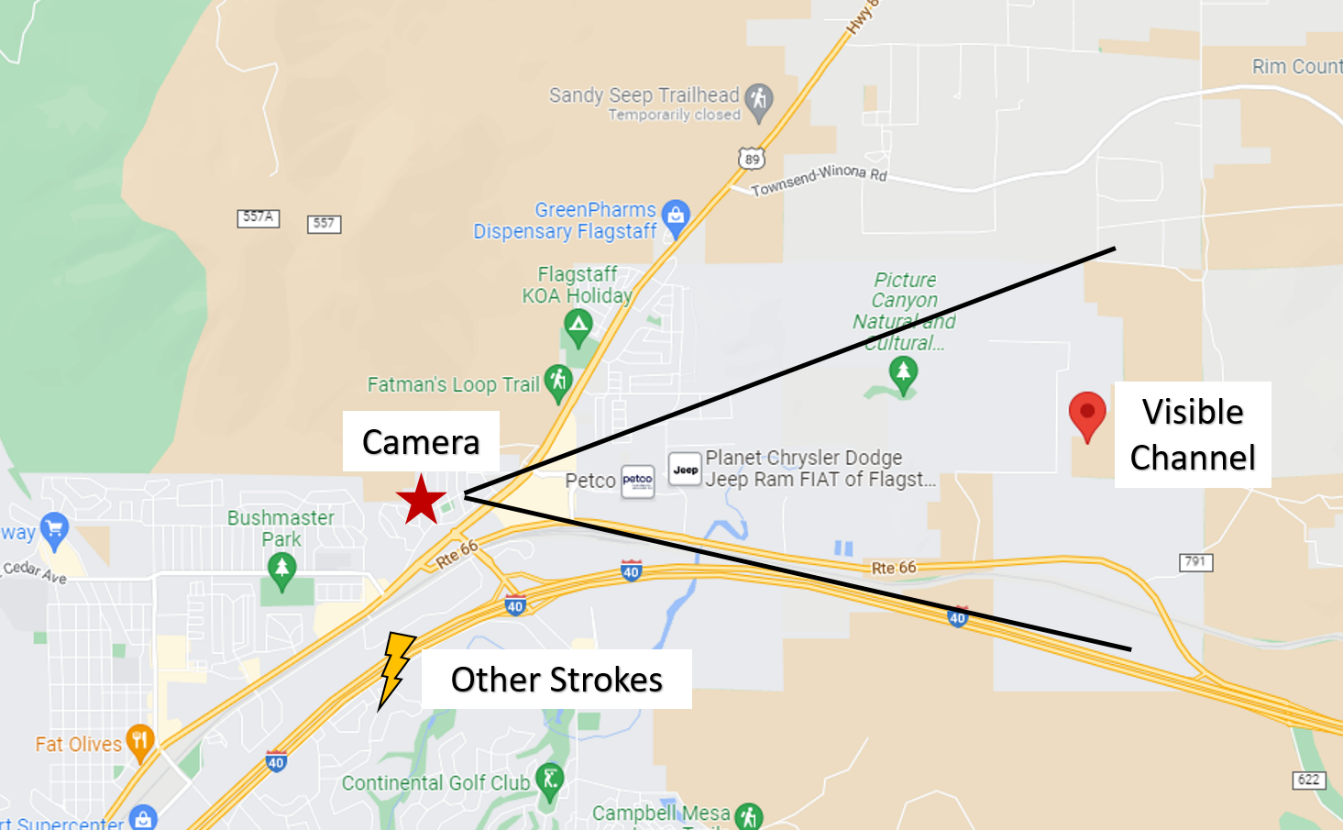
6/7/22
Daile Zhang attended and presented at the “Lightning as an Indicator of Climate” Annual Science Meeting that was held in the AOSC Department on June 6th and 7th, 2022. The meeting is an annual Working Group get-together for people from NASA, University of Arizona, City College of New York, University of Alabama in Huntsville, and University of Maryland on various lightning tasks/projects, including this year's NASA Marshall Space Flight Center CubeSpark project. Daile presented the work on the satellite lightning observations, funded by NOAA ROSES and the Raspberry Pi observations, funded by CISESS Seeds Grant.
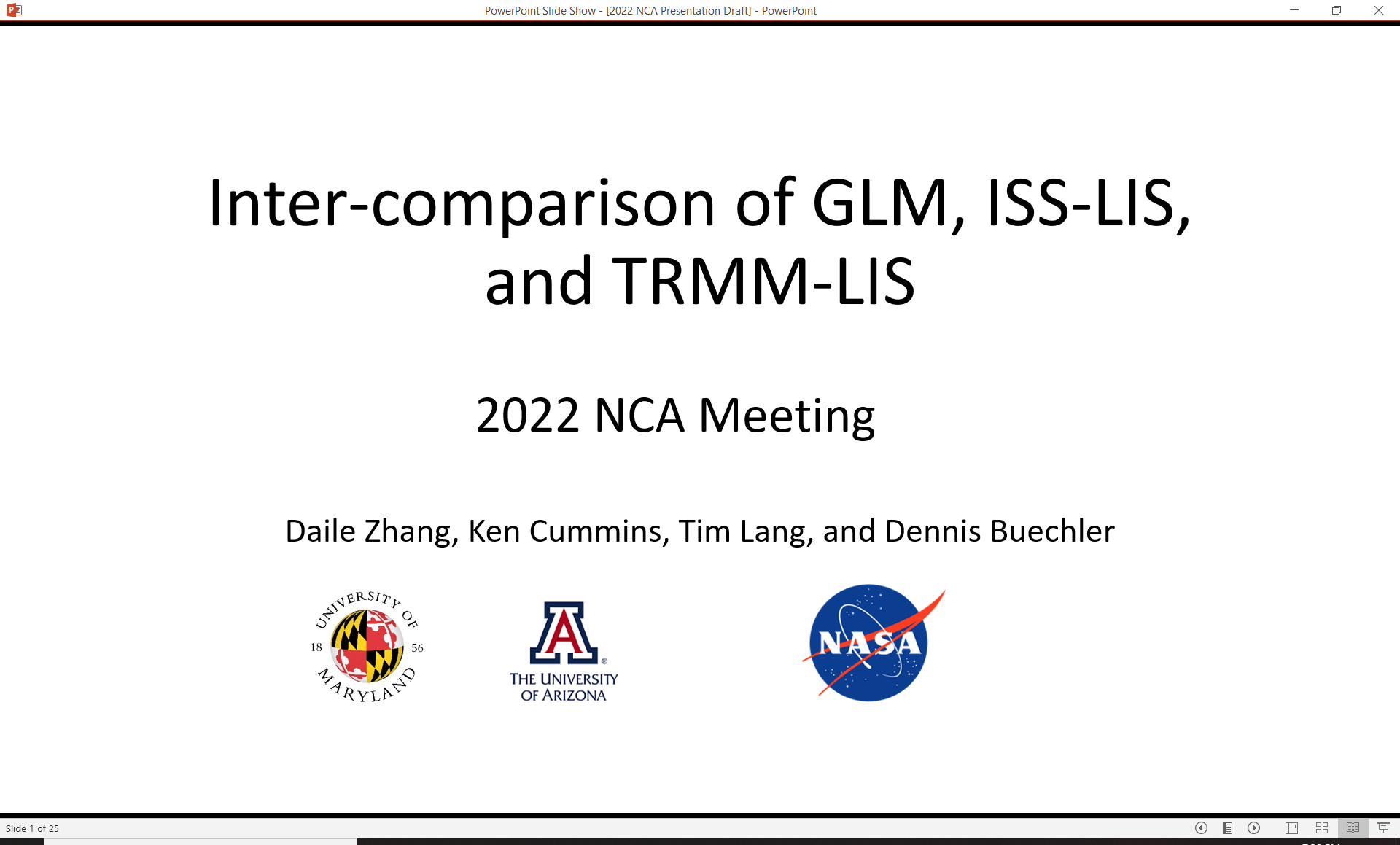
5/25/22
A Raspberry Pi camera was set up at the AOSC Department (on the roof of the Atlantic Building) on the UMD campus on May 23rd by Daile Zhang, Guangyang Fang and an AOSC undergrad student Domenic Brooks. This camera is part of the Mid-Atlantic Raspberry Pi camera network. The camera network will take high-speed videos of lightning and the videos will be used for evaluation and validation studies of the Geostationary Lightning Mapper (GLM) on NOAA's GOES-16 Satellite and other ground-based lightning networks, as well as long-term thunderstorm climatology study in the Mid-Atlantic area. This research project is supported by Zhang's 2021 Seeds Grant project of lightning observations, with Brooks and another undergrad student's summer internship at CISESS.
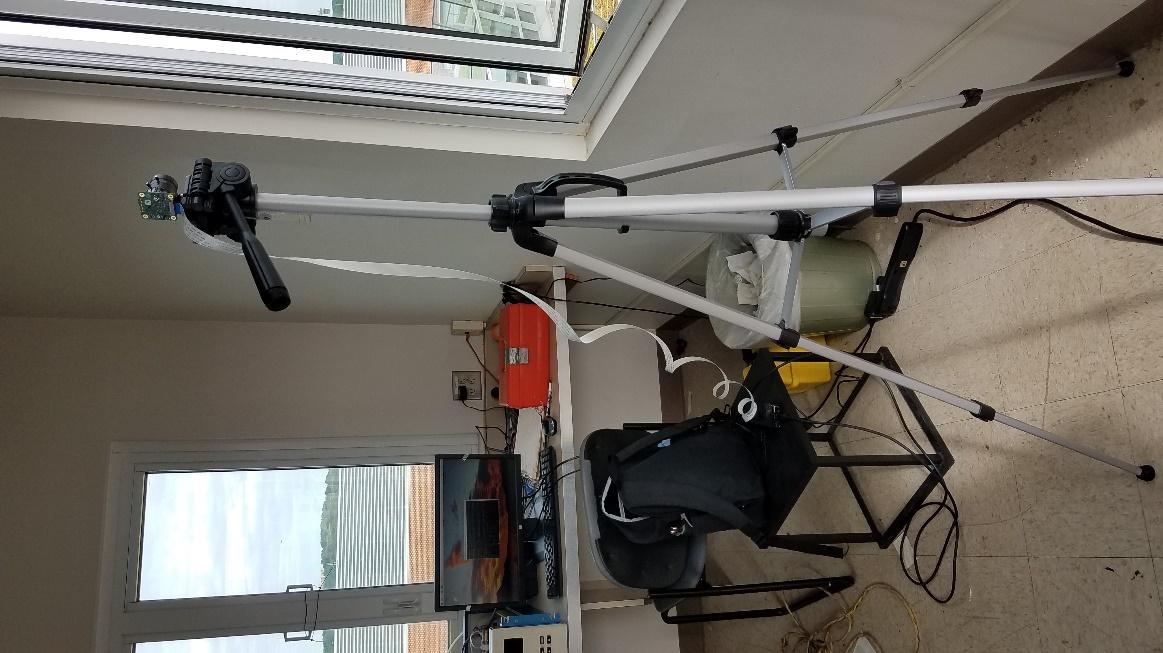
5/22/22
A storm passed over in the greater D.C. area in the afternoon of May 22, 2022. A 7-stroke cloud-to-ground (CG) flash was caught on one of the high-speed Raspberry Pi cameras in the Mid-Atlantic Raspberry Pi Camera network at Germantown. A CG flash typically has 3-5 strokes. Both Geostationary Lightning Mapper (GLM) on NOAA's GOES-16 Satellite and a ground-based lightning network - National Lightning Detection Network (NLDN) detected the flash. The work is to use the lightning videos to validate GLM and other ground-based lightning networks. The full video is available at: https://www.youtube.com/watch?v=kVR6HT62GDk. This work is sponsored by the 2021-2022 NOAA CISESS Seeds Grant and a collaboration with Earth Network and University of Oklahoma.
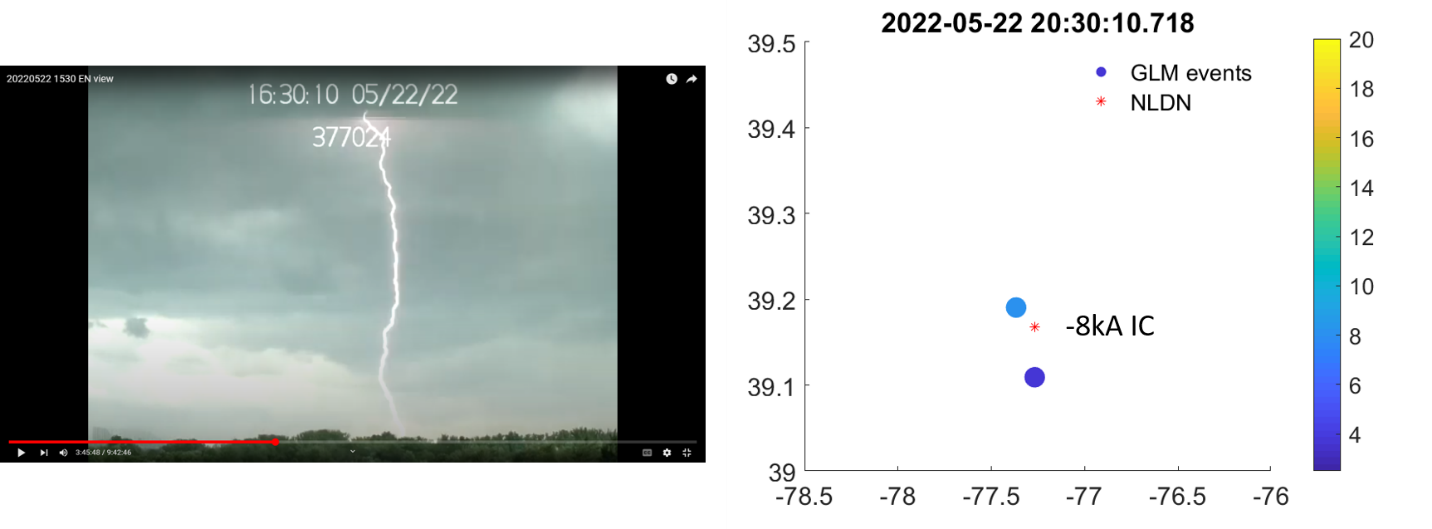
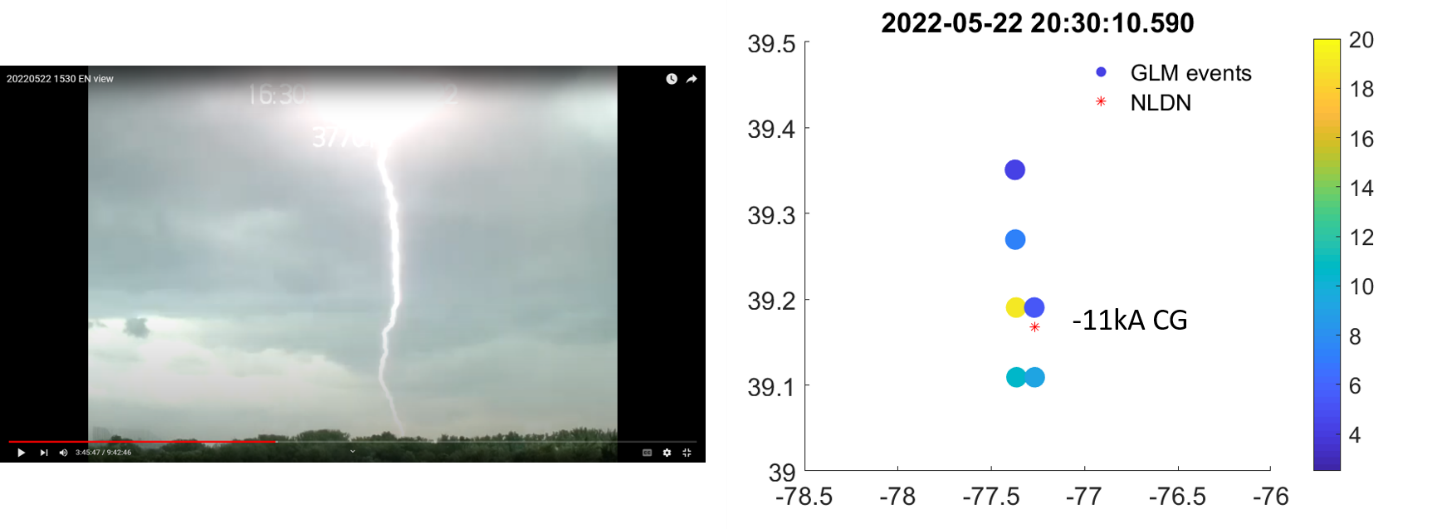
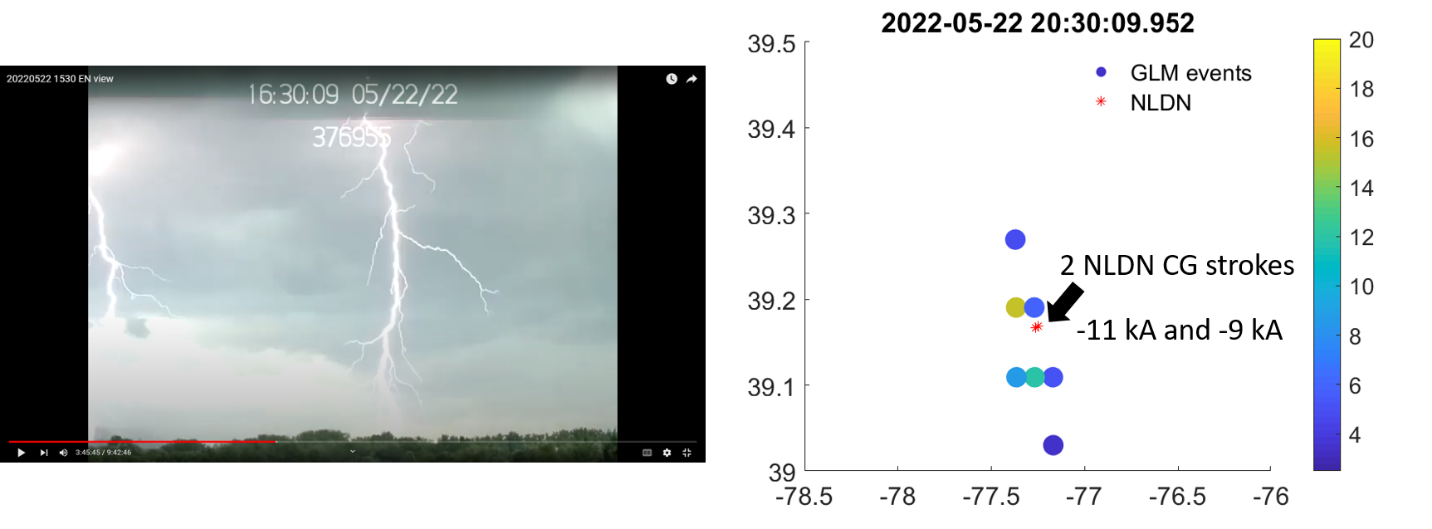
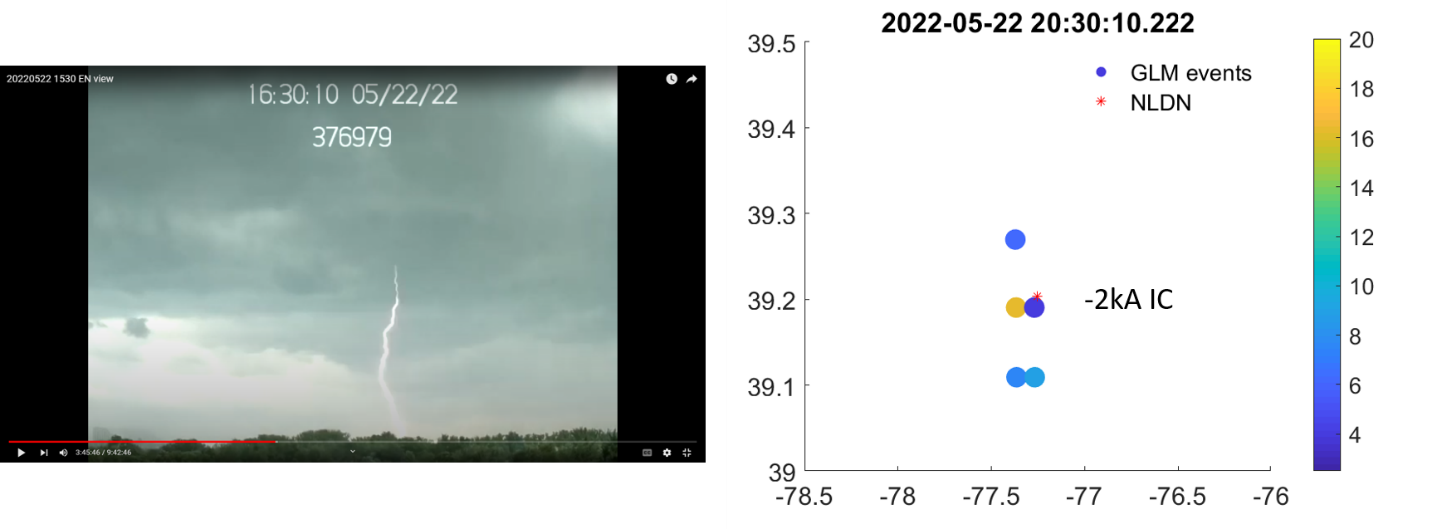

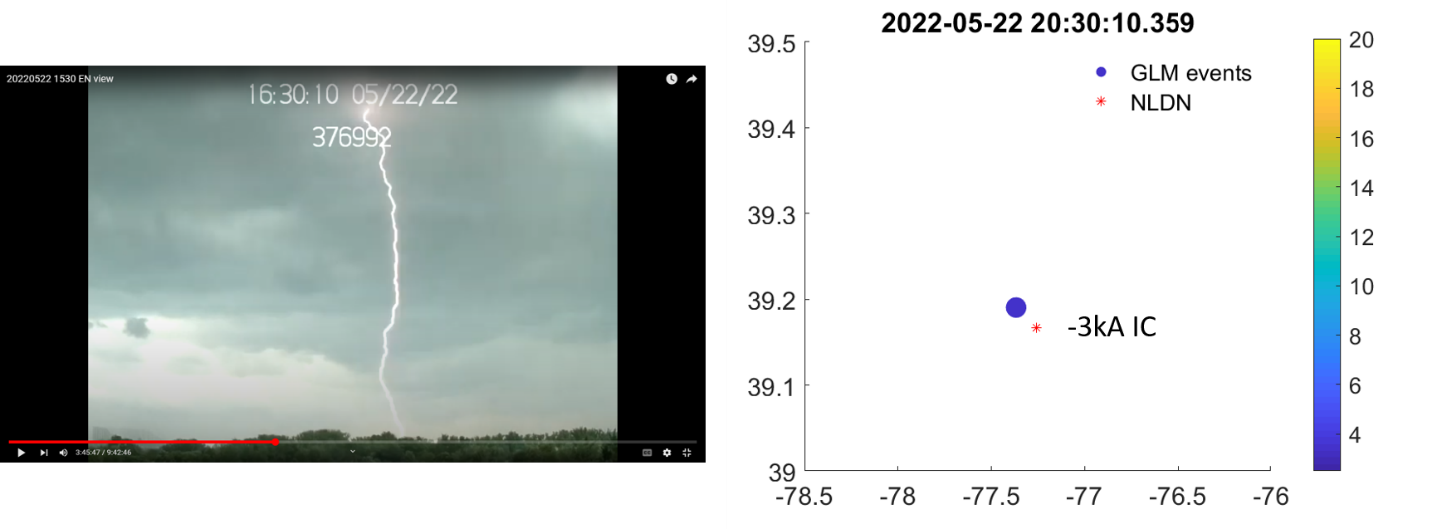
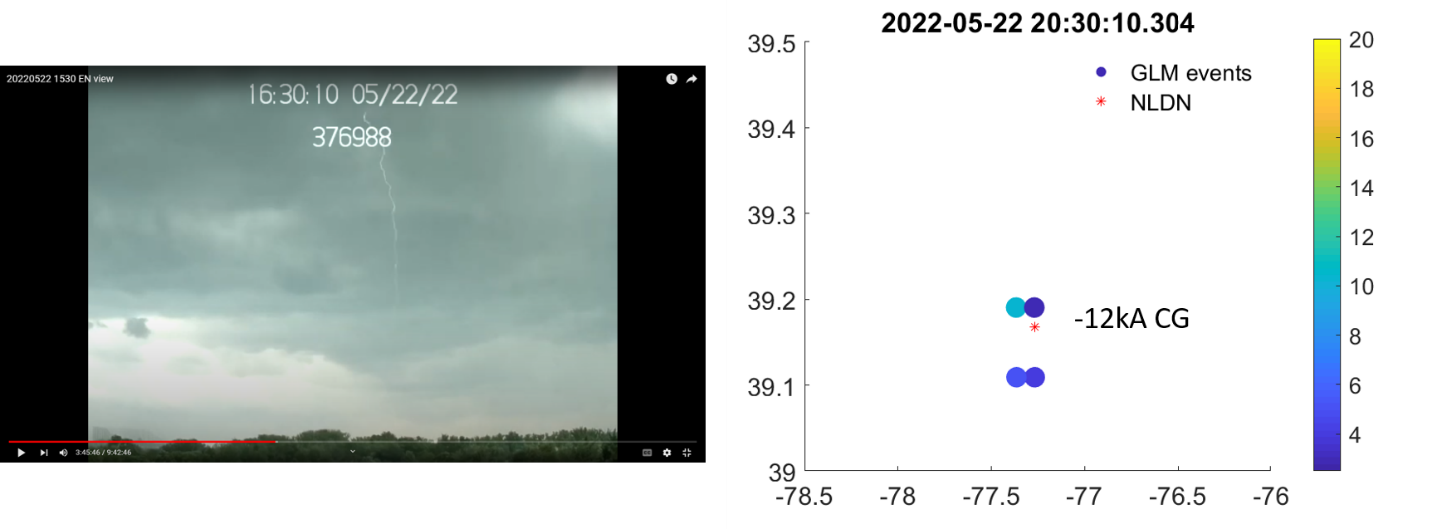
5/11/22
The CISESS lightning group including Guangyang Fang, Joseph Patton, Terrence Pierce, and Daile Zhang volunteered on the UMD Maryland Day on Apr. 30th, 2022. The group exhibited and demonstrated the NOAA satellite data virtual reality (VR) program. This VR program is an interactive and immersive “fly-through” of real weather data that allows users to visualize events like hurricane Dorian and an atmospheric river in a 3-D environment. The group also promoted lightning safety to the community. They distributed stickers and temporary tattoos with lightning safety slogans as well as answered questions about lightning safety that the community had. Maryland Day gathered thousands of kids and adults, making it one of the best showcase events in the city of College Park. The VR program was of great interest to kids. Left to right: Terrence Pierce, Joseph Patton, Guangyang Fang, and Daile Zhang.
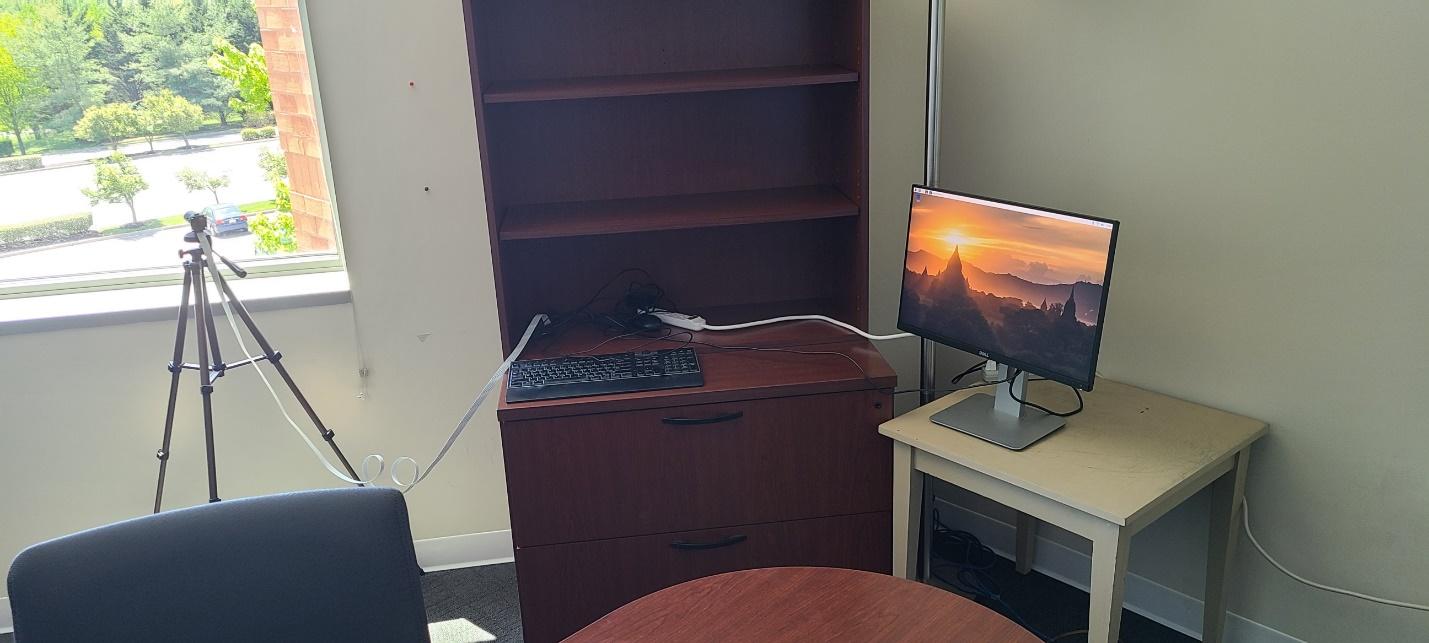
5/05/22
Joseph Patton and Daile Zhang site visited Earth Networks at Germantown on May 9th, 2022. Earth Network is a global meteorology company that owns and operates a national-wide lightning network (Earth Network Total Lightning Network, or ENTLN) and Zhang has collaborated with their scientists on various research projects over the years. The visit aimed at installing a Raspberry Pi camera at their headquarters office as part of Zhang's 2021 Seeds Grant project of lightning observations. The camera will be used to take relatively high-speed videos of lightning. The videos will be compared with the satellite sensor Geostationary Lightning Mapper (GLM) as well as the ENTLN for validation studies and thunderstorm climatological studies in the greater D.C. area and beyond. There are a total of 8 cameras out in the fields for observations (6 in Maryland and 2 in Oklahoma) for the upcoming storm season.
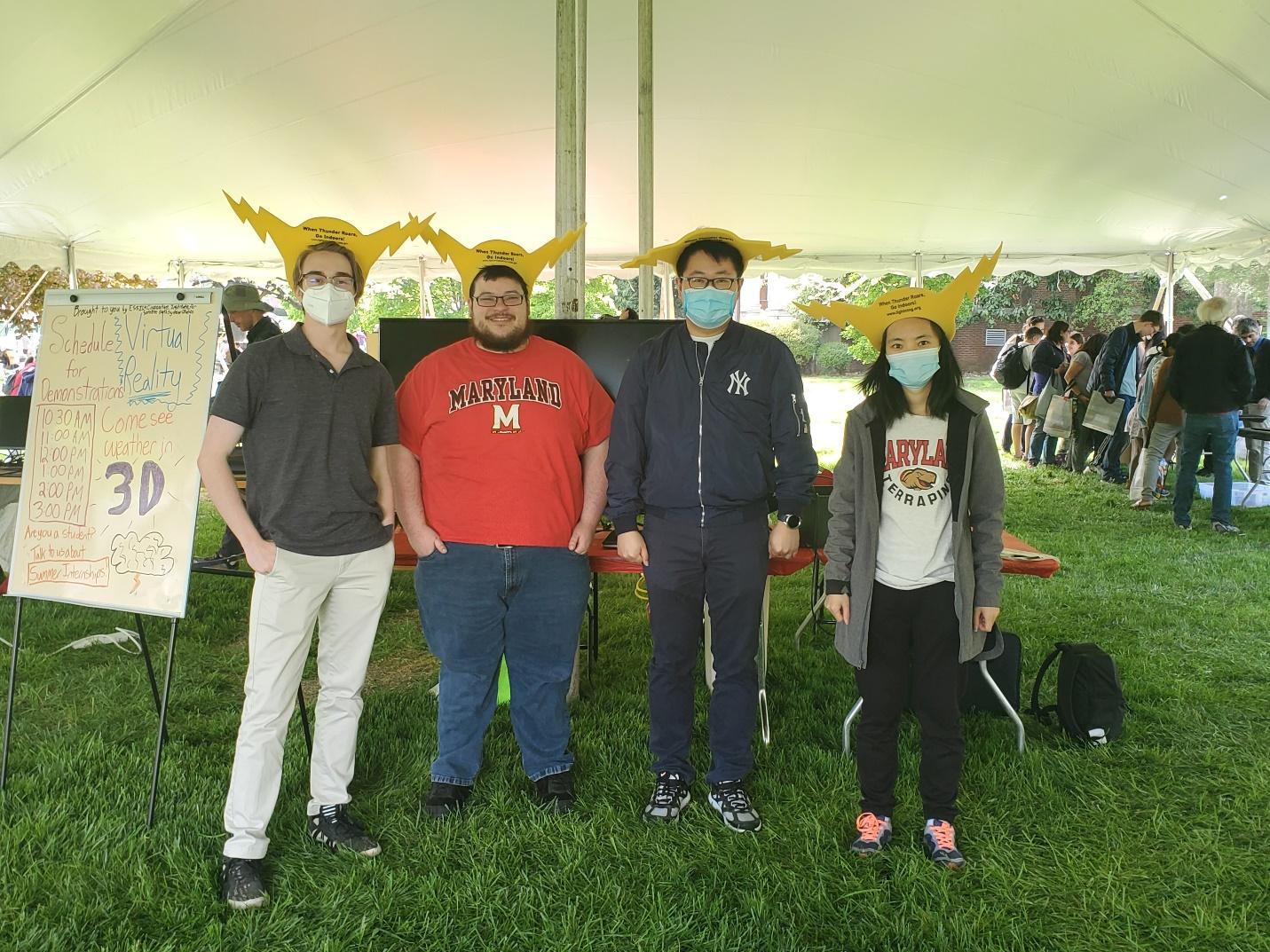
4/21/22
Daile Zhang was interviewed by the BBC Weather World, a TV programme about weather and climate in the UK and around the world. The programme featured the lightning records that were verified by the WMO this year. Daile explained how the lightning records were measured and the satellite technological developments that enable us to do this. The programme was aired on the BBC News Channel in the UK on April 15th.
4/1/22
GLM Team wins the American Astronautical Society (AAS) Award for outstanding achievement in Earth or Environmental Sciences, "recognizes the Geostationary Lightning Mapper Instrument Team for providing a novel and unique observational capability that has directly contributed to the nation's weather forecasting by improving severe weather observations, predictions, and warning lead-times, and having created new interdisciplinary research opportunities for the Earth and planetary sciences". This Institutional Award recognizes NOAA, NASA, and Lockheed Martin considering the long history of development and the many people who have supported seeing GLM through fruition.
3/11/22
On March 9th and 10th, CISESS Scientists Dr. Guangyang Fang, Joseph Patton, and Daniel Rodeheffer from LMA Technologies, LLC went to Howard University in Washington D.C. and Site 8 located at APL, Johns Hopkins University for a DC LMA site survey and maintenance. There have been noise issues at both locations. A new DC LMA station at Howard University will be installed before the beginning of the convective season that will hopefully mitigated this noise issue. However, before the convective season commences, the team still needs to take noise measurements on the rooftop to be sure it remains compatible for the new instrumentation. Due to spring break at Howard University, the rooftop was locked and only the 5th floor downstairs was open. After taking some measurements on the balcony of the 5th floor, we found the noise level in 30 seconds was -83 dBm for Channel 10, which is good for an LMA site. At another site, Site 8, located at Johns Hopkins University, there is a similar issue with strong background noise occurring even after the new preamplifier was replaced on October 23rd last year. Dan used a LMA sensor that does not generate noise to measure the background noise and found that the Site 8 noise level was around -50 dBm, which is too high for a good LMA station. Additional measurements were taken around the perimeter of the building hosting Site 8, and the noise readings remained high. In the future, another site survey will be conducted at Howard University, and we may consider relocation of Site 8.
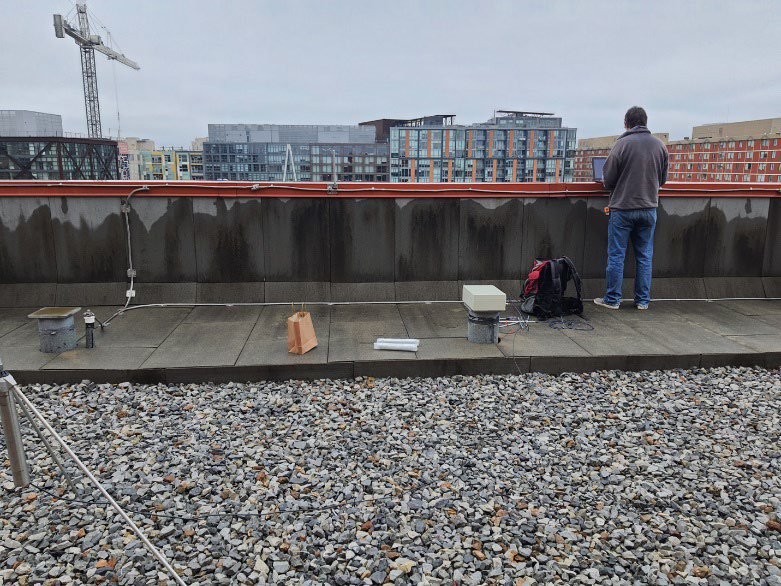
3/1/22
A giant lenticular cloud was seen in Maryland at about 5:50 pm on March 1st, 2022 (Fig. 1 and animation is available at https://twitter.com/nesecond/status/1498845725823836163). It was also detected by the GOES-East satellite (Fig. 2, and animation is available at https://dlzhang.files.wordpress.com/2022/03/g16_sector_ne_geocolor_60fr_20220301-2115-1.gif ). Lenticular clouds are common in the wintertime but can be seen all year around. They are formed when the air is moving fast and forced up by topographic barriers, such as mountains. This cloud was probably formed in the mountainous area in Virginia and moved to the east.


2/1/22
Daile Zhang, who serves on the World Meteorological Organization's Committee on Weather and Climate Extremes, helped certify two new WMO megaflash lightning records. The World Meteorological Organization (WMO) announced two new world records for megaflashes of lightning in notorious hot spots in North and South America: The longest single flash that covered a horizontal distance of 477.2 ± 5 miles (768 ± 8 kilometers) across parts of the southern United States on April 29, 2020. This is equivalent to the distance between New York City and Columbus, Ohio. The greatest duration for a single lightning flash of 17.102 ± 0.002 seconds from the flash that developed continuously through a thunderstorm over Uruguay and northern Argentina on June 18, 2020. The World Meteorological Organization's Committee on Weather and Climate Extremes recognized two new world records for megaflashes of lightning: (left) The greatest duration for a single lightning flash and (right) The greatest duration for a single lightning flash. Image courtesy of WMO.

1/7/22
Scott Rudlosky and Joseph Patton led an AMS short course titled “Accessing and Applying Geostationary Lightning Mapper Observations” on January 5 and 6. This two-part course introduced the GLM observations and imagery using GLM flash skeletons and gridded products used by the National Weather Service. Participants were shown how to access archived and real-time imagery before conducting a hands-on exercise illustrating their new-found skills. Additional information can be found at this link - https://www.ametsoc.org/index.cfm/ams/education-careers/careers/professional-development/short-courses1/accessing-and-applying-geostationary-lightning-mapper-observations/.
12/16/21
CISESS lightning team Guangyang Fang, Joseph Patton, Daile Zhang and Terrence Pierce attended the 2021 American Geophysical Union (AGU) Annual Conference. Joseph and Daile gave an invited talk on Using the Geostationary Lightning Mapper to Analyze Convective Activity for Operational Meteorology, and Fusing GEO and LEO Lightning Observations, respectively. Guangyang and Terrence gave a poster presentation on Update of Maintenance and Development of the Mid-Atlantic Lightning Mapping Array (MALMA), and A Case Study Inter-comparing MALMA and GLM, respectively. Former lightning research scientist Mason Quick also gave a talk on A calibration baseline for lightning radiometry from space. Joseph and Daile co-chaired Meteorology and Climatology of Atmospheric Electricity and Lightning Poster, and Oral sessions, respectively. Mason and Daile served as conveners for Physics of Streamers, Leaders, and the Lightning Discharge: Observations, Modeling, and High-Resolution Data Analysis session, and Meteorology and Climatology of Atmospheric Electricity and Lightning session, respectively. Daile also served as an OSPA coordinator for the Atmospheric & Space Electricity section.


12/10/21
On Friday, December 10th, S. Rudlosky presented on operational applications of the Geostationary Lightning Mapper as part of a cross-line office briefing to the House Committee on Science, Space, and Technology, and the Senate Committee on Commerce, Science, and Transportation. The briefing received very positive feedback and did a “great job of showing the connections from observation to real-world use in an easily understandable way. The staff didn't have many questions, which is not atypical, it sounds like they found it really informative and useful”.
11/8/21
CISESS lightning team Joseph Patton and Daile Zhang attended the 2021 Mid-Atlantic ChaserCon, held at the Science Museum of Virginia in Richmond, VA on November 6th, 2021. The conference aims to provide a forum for meteorologists at National Weather Service, broadcast meteorologists, emergency managers, storm chasers and other professional and amateur meteorologists across the great Mid-Atlantic area to network and discuss local severe storms and promote ideas to raise public awareness of severe weather and emergency management. The lightning team informed meteorologists of the use and value of the NOAA's Geostationary Lightning Mapper (GLM) gridded products. The meteorologists spoke highly of the operational GLM data as an instrument that continuously observes lightning activity, tracks thunderstorms, and improved severe weather forecasting and nowcasting. Their positive feedback is also helpful for the lightning team to better serve the community.

10/29/21
Daile Zhang was invited to give a zoom talk at the Arizona State University Sun Devil Weather and Climate club monthly meeting. The Sun Devil Weather and Climate club serves its undergraduate meteorology program and is run by the undergraduate students in the School of Geographical Sciences & Urban Planning. Daile talked about her work on lightning detection from space as well as the Global Electric Circuit in which thunderstorms and lightning play a key role. The students showed many interests in her work and ball lightning. Daile also shared her story of how she became a lightning scientist with the students.

10/18/21
At 10:00 AM this Monday, October 18th, 2021, Guangyang Fang and Joseph Patton visited our DCLMA station at the College of Agriculture & Natural Resources at Upper Marlboro, MD (Ag site) to fix the VHF antenna issue. During the latest thunderstorm on September 28th, this site did not catch the lightning flash. The LMA technician suspected the preamplifier was out of function. For this site visit, we replaced the preamp with a good one, and the threshold of the LMA sensor went up by about 5 dBm, which indicates that the new preamp is better than the old one in amplifying the surrounding noise. However, we still need an active storm to verify that the preamp is at full power. Since all these amplifiers are old, even though it's better than the other one, there is still a chance that it's not at full power. In addition, we replaced the charger and the backup battery, which were not working properly at this site. We also installed the ethernet surge protector and the corresponding grounding device to avoid lightning strike in the future.

9/29/21
The UMD lightning team Joseph Patton and Daile Zhang helped NOAA's 2021 GOES-R Hackathon in the week of September 20th as the role of Subject Matter Experts. The Hackathon aimed at providing an opportunity for undergraduate students from diverse backgrounds to collaborate and develop interdisciplinary solutions to contemporary environmental issues using GOES-R Series geostationary satellite data. Students worked in a team to solve real-world problems with GOES-R satellite data products. Joseph and Daile held several office hours during the Hackathon to answer questions that the students may have. In addition, Joseph, along with a NESDIS senior scientist Andrew Heidinger, gave a tutorial presentation on GOES-R Satellites and Products at a training session to the student participants before the Hackathon.

The UMD lightning team (Scott Rudlosky, Guangyang Fang, Joseph Patton, Feng Zhang, and Daile Zhang) organized and presented at the 2021 annual Geostationary Lightning Mapper (GLM) Science Meeting (virtual) between Sep. 21st and 23rd . The GLM is a near-infrared optical transient detector on both NOAA GOES-16 and -17 Satellites, and planned to be deployed on the new GOES-18 Satellite. Various topics were presented by the team. Scott presented “Status of Operational GLM Products” and “Quantifying the Value of Using GLM to Fill Radar Coverage Gaps.” Guangyang presented “Maintenance and Development of the Mid-Atlantic Lightning Mapping Array (MALMA).” Joseph presented “Sources of False GLM Returns.” Feng presented “Blending Lightning Data from Space- and Ground-Based Networks.” Daile presented “Inter-comparison of ISS-LIS, TRMM-LIS, and GLM.” The meeting was very successful and well attended with over 80 participants from a few countries.
9/9/21
Terrence Pierce, a rising senior from the Poolesville High School, worked with the CISESS Atmospheric Electricity team during the summer. His work mainly focused on designing the Atmospheric Electricity Research & Training (AERT) website and constructing them into working code. The current websites consist of several pages that allows users to interact with GOES GLM lightning data with real-time lightning data maps and acquire archived data. He now works with the IT people to transition the codes to a testing mode. In addition, he involved in several other AERT research projects including the D.C. Lightning Mapping Array (DCLMA) maintenance (left), satellite data Virtual Reality (middle), as well as Raspberry Pi and 360 cameras lightning observation (right). He will be continuing working with us in the fall semester and will present his contribution on the DCLMA and Raspberry Pi project at the AGU annual conference in December.

8/27/21
The DCLMA station at Northern Virginia Community College in Woodbridge (NVCC_Woodbridge) was relocated successfully. The facility manager Anthony indicated that the Seefeldt building, where the LMA station was previously located, would undergo renovations this year, and all antennas on the rooftop would be moved to the neighboring Arts and Science building. After preparing for months, Joseph and Guangyang have finally completed the relocation with the help of contractors who we hired. The GPS and VHF signals at this station had been weak or zero. This problem had been persistent since at least 2018 and was likely caused by the long cable runs with signal loss. During the relocation, Joseph and Guangyang resolved this issue by replacing the VHF antenna, the GPS antenna, the pre-amplifier, all the cables, the power supply, and the backup battery with new ones. The brand new low-signal-loss coaxial cable (LMR-400) for GPS was used to reduce signal loss. Joseph and Guangyang also used the new ethernet cable and new power extension with surge protection to avoid possible lightning strikes. The contractors were working on the installation for 5 hours from 6:00 AM to 11:00 AM. Joseph and Guangyang worked on the IT configuration and the internet connection thereafter until 3:00 PM with the remote help of Dan Rodeheffer, the technician from LMA Technologies, LLC. The name of this site was changed from dclma_b to dclma_j on the LMA server to avoid possible confusion. Everything was set and the LMA site was operating well. Now there are strong VHF and GPS signals at this site. The current status of all sites including this one in Woodbridge can be checked on http://199.47.207.19/dclma/. The picture shows the new LMA antennas on the rooftop of the Arts and Science building (center), the LMA computer box in the control room (right top), contractors (left top), Joseph Patton (left bottom), and Guangyang Fang (right bottom).
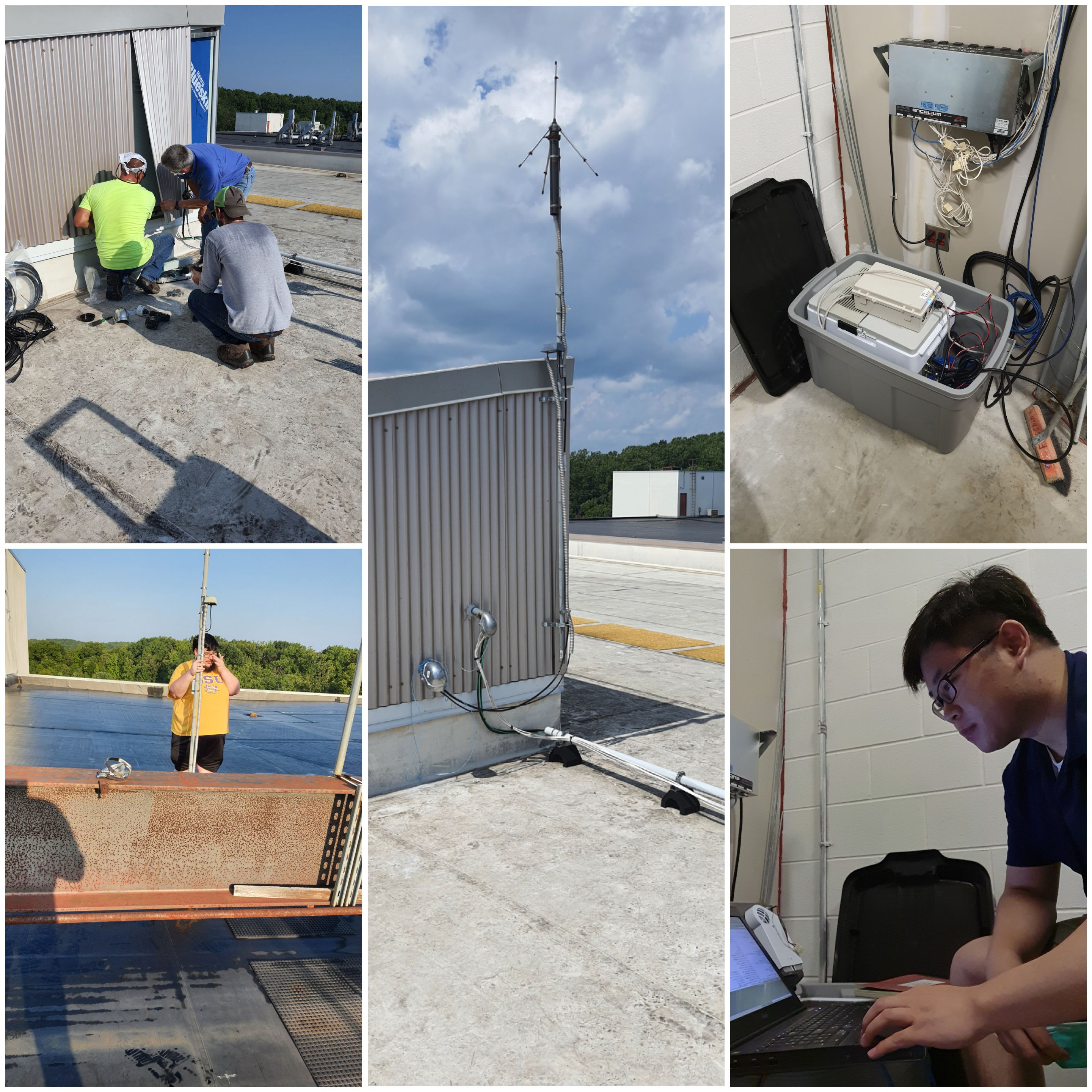
7/20/21
Guangyang and Joseph visited one of our DCLMA stations at the College of Agriculture & Natural Resources at Upper Marlboro, MD (Ag site) to fix the intermittent disconnection issue. A lightning strike hit this entire station around 5:00 to 5:30 PM on June 8th . Thereafter, they replaced the LMA computer, the battery, and the power supply. This time, Guangyang and Joseph upgraded the ethernet cable and the power extension cord with surge protection to avoid possible lightning strikes in the future. they found the battery was dead (only about 6 volts) and the power supply was off as seen in the picture when they inspected them. The power supply went back to work after they tapped it. Therefore, the possible reason for the disconnection issue at this site is the faulty power supply or the power extension cord, which might have a bad connection inside. Guangyang and Joseph replaced the dead battery with a new one and made sure everything runs well before leaving. Next time, they will come back to replace the suspicious power supply and complete the grounding of the ethernet surge protector.
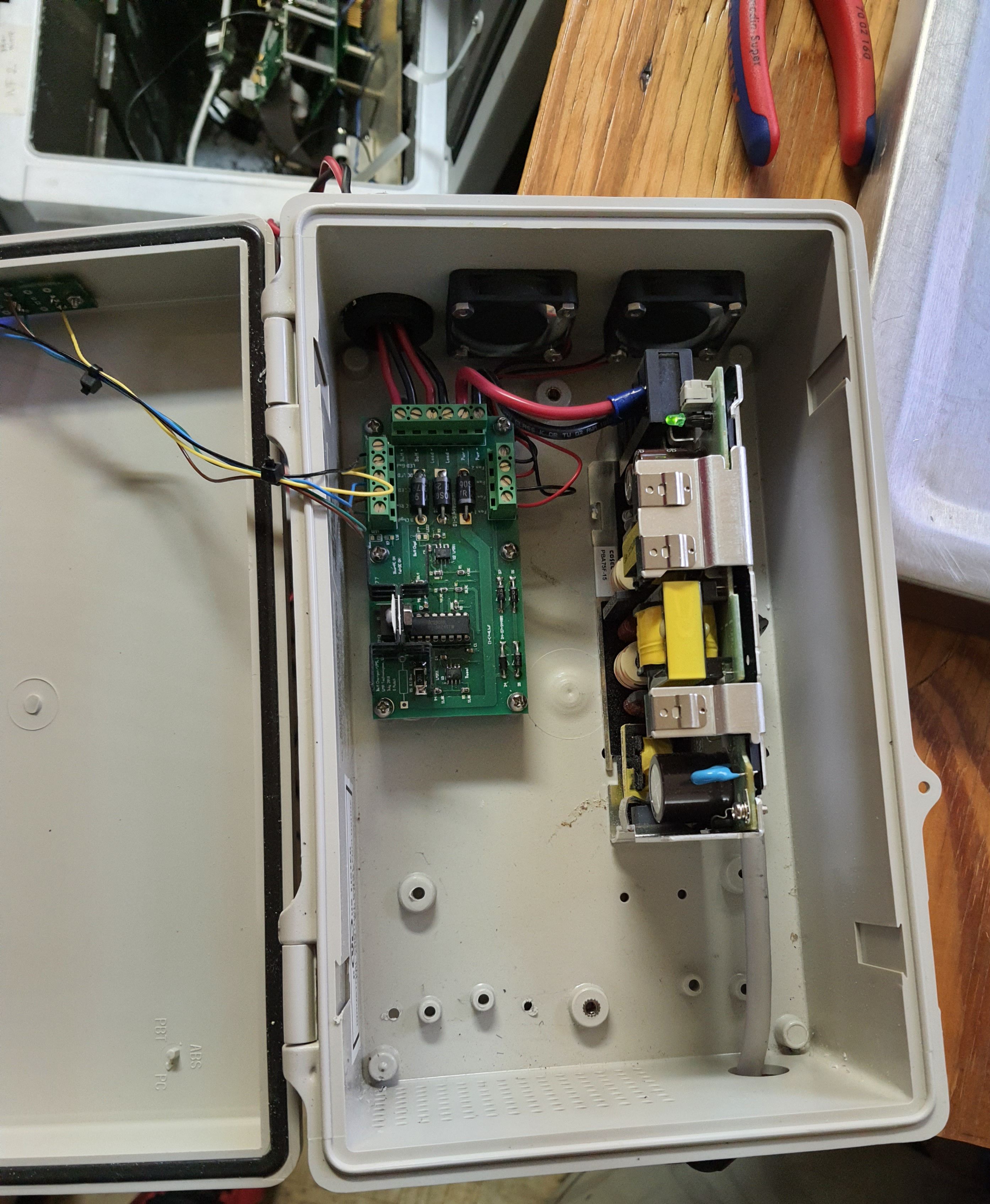
7/6/21
Guangyang, Joseph, and our summer intern Terrence visited one of the DCLMA stations on the campus of Howard University-Beltsville to fix the GPS issues. The GPS signal at this station has been weak and unstable since they upgraded it several months ago. They contacted the GPS supplier and found that the real issue is probably the coaxial cable itself. Therefore, they cut out the extra length of the coaxial cable to reduce the signal loss and they crimped new connectors on both ends of the GPS cable to boost the stability of the connection. It turns out that problem was perfectly resolved because the site in Beltsville has been working smoothly and the GPS signal is strong and stable since then. The current status for each site of DCLMA can be seen from the website http://199.47.207.19/dclma/.

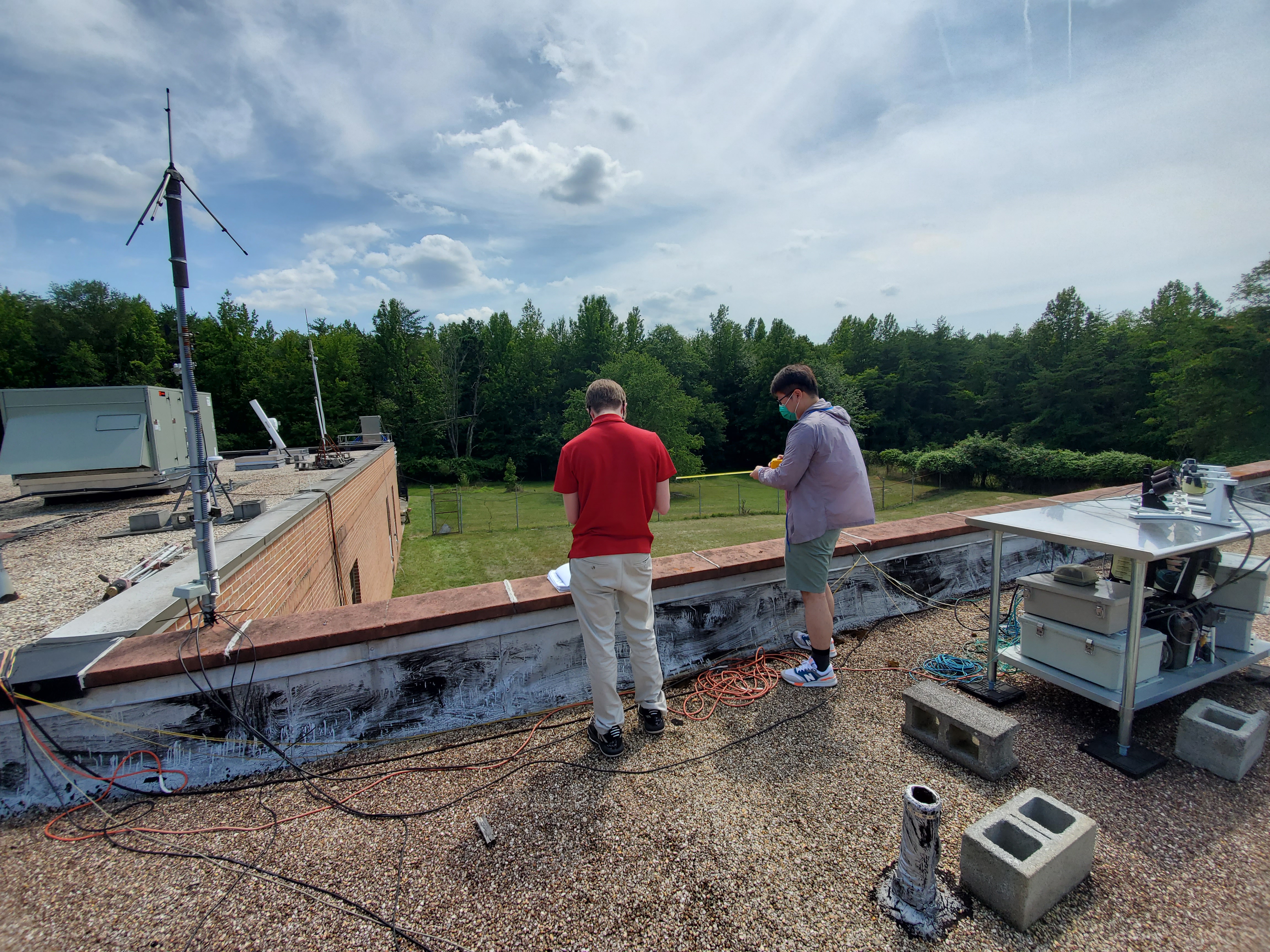
6/11/21
Lightning Safety Awareness Week: Scott Rudlosky presented a (Brief) Science of Lightning at the NWS Baltimore/Washington Lightning Safety Workshop on June 8. This workshop brought together ~80 meteorologists (NWS, aviation, maritime, broadcast) and emergency managers to help craft a common message for the upcoming Lightning Safety Awareness week.

6/1/21
Daile Zhang was invited to give a talk at the meeting for the Preparing for Lightning Hazards - Preparing for 2021 International Lightning Safety Day. It was the lightning safety meeting with most participants and countries involved. There were 237 participants from 24 countries with 29 speakers from 17 countries. The meeting also had 14 domestic and international Lightning Safety Advocacy Programs (e.g. the U.S. National Lightning Safety Council, the African Centres for Lightning and Electromagnetics Network) as well as the World Meteorological Organization involved. Daile talked about Lightning Detection from Space: how to obtain and use satellite lightning data. It provides the information of how to obtain the archived and current satellite-based lightning data and how to use them for lightning safety studies, especially for countries with no lightning or radar data available. The meeting videos are available at https://www.youtube.com/playlist?list=PLapqki8XmjgYQxVewilOVPdMpfLYw9kuM.

4/26/21
The National Lightning Safety Council is working to shine a spotlight on the lightning hazard and expand its mission to promote lightning safety awareness. This month the Council connected with member, Daile Zhang, to discuss her role in the lightning safety effort. http://www.lightningsafetycouncil.org/LSC-GTK-Zhang.

1/20/21
Daile Zhang, a CISESS postdoc associate, presented her poster of An Initial Intercomparison of GLM and ISS-LIS Lightning Observations at the 10th Conference on the Meteorological Application of Lightning Data at the 2021 AMS Annual Meeting (Jan. 9-15, 2021). Daile’s work combines the GLM and ISS-LIS observations to develop the GLM-LIS cloud-top optical products empirical relationships. The results will help identify and characterize storms that cause reduced GLM detection efficiencies and may also help to reduce GLM parallax location errors.

1/4/21
The CISESS lightning team has made its appearance on the current newsletter (Vol. 31, No. 2, Nov 2020) of the International Commission on Atmospheric Electricity (ICAE). The ICAE is a commission of the International Association of Meteorology and Atmospheric Sciences (IAMAS) that promotes scientific study, education and public awareness of electrical phenomena in the atmosphere.


1/4/21
Daile Zhang, a post-doc associate of CISESS, co-chaired and presented at the 2020 AGU Atmospheric Electricity section (Dec. 8-11, 2020). Daile presented her work of an Evaluation Study of the International Space Station Lightning Imaging Sensor and co-chaired both the eLightning and the oral session of the Thunderstorm Electrification and Lightning Meteorology. She also served as one of the conveners other 2 sessions. The virtual sessions went successfully with a total of more than 200 attendees.
12/8/20
Daile Zhang helped organize and attended the first International Lightning Research Seminar, which was held on December 4th and 5th, 2020 over zoom. This seminar aims primarily for graduate students and early career scientists who wish to expand their research in various lightning topics. Lightning scientists over 14 organizations and institutions from 10 countries present the scopes and opportunity on the various facets of lightning, trends, challenges, opportunities and potential sources of funding. The meeting had over 80 attendees. The meeting videos are available at: https://www.youtube.com/playlist?list=PLapqki8XmjgYrcEQ1KXHsyaAZZxeA5AzH
9/30/20
Michael Peterson, a former CISESS researcher who now works at the Los Alamos National Lab won the Gold at the R&D 100 Conference in the Special Recognition category for its Cluster Integrity, Exception Resolution, and Reclustering Algorithm (CIERRA). This was a collaborative effort with CISESS, University of Maryland. Twitter feed: https://twitter.com/RD100Awards/status/1311033514314346500

9/10/20
The UMD lightning team (Scott Rudlosky, Mason Quick, Jonathan Smith, Joseph Patton and Daile Zhang) organized and presented at the 2020 annual Geostationary Lightning Mapper (GLM) Science Meeting this week (Sep. 8-10). The GLM is a near-infrared optical transient detector on the NOAA GOES-16 and -17 Satellites. Various topics were presented by the team. Scott presented "Initial GLM Climatology and Performance Assessment" and "GLM Data Query Tool." Daile presented "Downscaling of GLM Lightning Observations Using ISS-LIS Data." Jonathan presented "Status of GLM Gridded Products." Joseph presented "GLM Training Overview." Although it was the first time that the meeting went virtual, it was very successful and well attended (~80 participants for each session).

6/30/20
Daile Zhang helped organize and attended the first International Lightning Safety & Protection Meeting, which was held on June 24th and 25th, 2020 over zoom. This was the first time that over 30 organizations from 12 countries get together sharing their work and discussing potential future collaboration on lightning safety awareness education and protection, especially for developing countries in Africa and south Asia. Daile also helped create a YouTube channel for the International Lightning Safety & Protection Council and uploaded the meeting videos at https://www.youtube.com/channel/UCjh9VO4xeJHe80rEAZJPyqQ.
6/10/20
Last week, Daile Zhang became a member of the National Lightning Safety Council (NLSC, http://lightningsafetycouncil.org), which was established to promote lightning safety education and awareness. The NLSC will work with NOAA to provide the public with safety information about lightning, especially during the upcoming National Lightning Safety Awareness Week during June 21 - 27, 2020 and the International Lightning Safety Day on June 28, 2020. Daile has worked closely with some of the members since she was a PhD student.
5/6/20
Daile participated in the EGU annual meeting online this week as a co-author of an abstract of Atmospheric Electricity, Thunderstorms, Lightning and their effects. The EGU provides an online Chat software to allow the participants to communicate with the authors. She will also be attending a machine learning short course next week.

3/10/20
Two papers have been published recently. One is “Time Evolution of Satellite-based Optical Properties in Lightning Flashes, and its Impact on GLM Flash Detection” by Daile Zhang and Ken Cummins (University of Arizona). The paper is published in the Journal of Geophysical Research: Atmospheres Special issue: A New Era of Lightning Observations From Space. The other is “Thunderstorm Cloud-Type Classification from Space-Based Lightning Imagers” by Michael J Peterson (Los Alamos National Laboratory), Scott Rudlosky and Daile Zhang. The paper is published in the Monthly Weather Review by the American Meteorological Society.
10/26/19
The CISESS lightning team went to the Mid-Atlantic ChaserCon at Richmond, Virginia on Oct. 26th, 2019. The conference aims to provide an opportunity for meteorologists at National Weather Service, broadcast meteorologists, storm chasers and other professional and amateur meteorologists across the Mid-Atlantic area to meet face-to-face to network and discuss local severe storms, raise public awareness and provide tips about storm chasing in this area. The lightning team discussed with meteorologists at the meeting for the use of the satellite lightning products - the Geostationary Lightning Mapper (GLM) gridded products. The meteorologists spoke highly of the operational GLM data of being continuously observing lightning activity and help track thunderstorms and improve severe weather forecasting and nowcasting. Their positive feedback is also helpful for the lightning team to better serve the community.

10/10/19
Fernando Miralles-Wilhelm and Daile Zhang exhibited and demonstrated the NOAA satellite data VR application at the annual College Park Day. College Park Day gathered thousands of kids and adults, making it the best showcase event in the city of College Park. The VR application was of great interest to kids.

9/29/19
Mason Quick (CISESS; pictured below) attended the MAVRIC conference in Washington, DC. His presentation described the development of software to visualize NOAA satellite Earth science data sets in virtual reality. The MAVRIC conference brings together individuals from academic, private and government organizations who are working in the field of immersive media.

9/20/19
Patrick Meyers (CISESS) attended the Satellite Ingest and Display Evaluation (SIDE) workshop to discuss AWIPS2 development and implementation at NOAA National Centers. The meeting, hosted by CIRA, was attended by TOWR-S AWIPS developers, forecasters and satellite liaisons for national centers (NHC, SPC, and AWC were represented), and satellite product developers. The team identified technical and training needs for transitioning forecasters from NAWIPS to the new AWIPS2 software used by NWS forecast offices. Task groups were created to implement code changes that aim to facilitate forecaster access and use of satellite data. Meyers is a key member of the CISESS-SCSB Satellite Proving Ground and Training Facility. While in Colorado, Patrick visited the COMET/MetEd team to demonstrate virtual and augmented reality (VR) applications using geophysical data. COMET provided excellent feedback on CISESS's TMP VR demonstration, calling it the "most advanced VR software for meteorological data" they had seen yet (see examples below). The software allows a user to view and interact with select satellite, model, and radar data for an atmospheric river event from February 2019. Demonstrations are available by request at the CISESS Satellite Proving Ground and Training Center.

Scott Rudlosky co-hosted the GLM science meeting in Huntsville, AL September 10-12, where he presented on the status of GLM products. CISESS scientists Mason Quick and Jonathan Smith, and JMA visitor Ryo Yoshida, also attended, and presented on validation efforts and NWS gridded products, respectively. RAMMB scientist and current GOES-R program scientist Dan Lindsey, was also in attendance. This annual meeting brings together the largest gathering of GLM scientists and operational users. The coincident National Weather Association meeting in Huntsville also helped boost attendance (see photo below).
